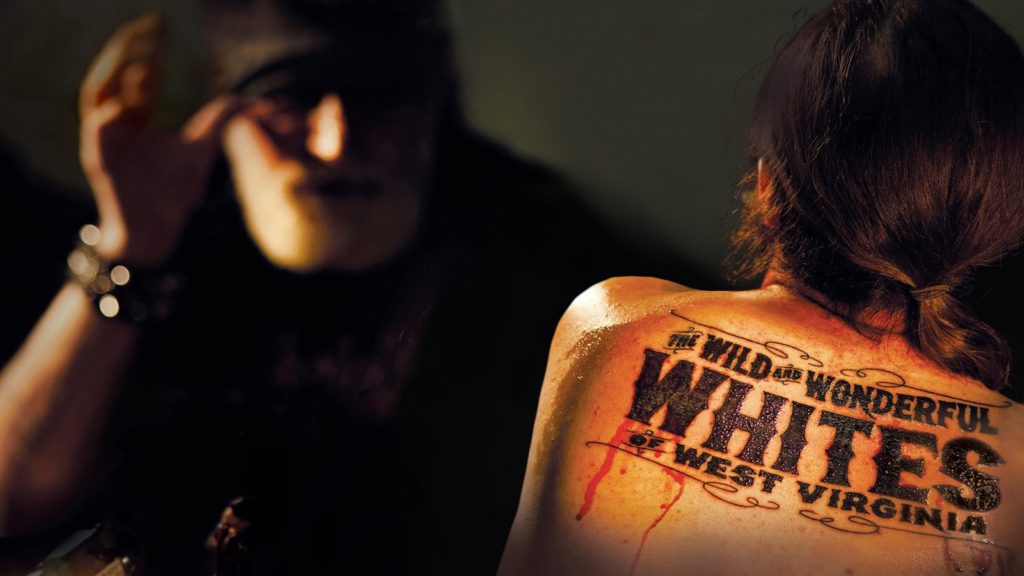One of the critical questions that has come up even in some recent Urban Appalachian Community Coalition blog posts is the complex idea of Appalachian identity. This question becomes particularly complicated since UACC is primarily focused on urban Appalachians, some of whom may be a generation or two removed from the Appalachian region. Elizabeth Catte tackles some of the thorny questions regarding Appalachian identity and history in her book What You are Getting Wrong About Appalachia.
In the 2009 film The Wild and Wonderful Whites of West Virginia, we get a portrait of the White family of Boone County West Virginia, the most famous, or infamous, of which is Jesco White, known as “the Dancing Outlaw.” This film offers a mind-boggling portrait of some stereotypical hillbillies who have moved into modern times primarily by replacing the moonshine jug with snorting Oxycontin. While the documentary on the White family is tragic, it is also a non-stop portrait of hell-raising, boozing, and dope with damn little emphasis on the reasons why people in Appalachia fell prey to the marketing of opioid drugs by corporate giants who gave no thought to the lives they would destroy in selling one of the most addictive drugs ever invented. And we never learn anything about the boy at MIT. This narrow focus of the camera with an eye toward preconceived notions of backward Appalachians is the first thing Elizabeth Catte takes to task in What You are Getting Wrong About Appalachia.

One of many things that characterizes Catte’s approach to her critique of the way people understand Appalachia and Appalachians is to reveal the way people look at things, to reveal the gaze, if you want the intellectual term for this type of thing. The way power situates its gaze on something will always re-affirm the system of power that gazes, and this is what Catte shows us. Whether people want to sympathize with the poor ignorant Appalachian who got suckered into voting against his or her interest in the form of Trump, or demonize these bumpkins dead-set on dragging the nation down to their level, it always comes down to what Catte describes as “a willingness to use flawed representations of Appalachia to shore up narratives of an extreme ‘other America’ that can be condemned or redeemed to suit one’s purpose” (35). The portrait of Appalachians is pre-arranged according to a set of ideas already in place.
Catte delves into some of the origins of this picture of Appalachia and Appalachians. The image of the feuding Hatfields and McCoys at a dinner theater in Pigeon Forge, Tennessee opens a window into how the ideas of wild and primitive mountain people persist in myths that go back for centuries. Even the well-intentioned “origins” of the people of the Appalachian regions in the early Scots-Irish settlers is revealed to be yet another oversimplification that has at its heart yet another atavistic kernel to add to the primitive image of Appalachians. The section that treats the history of the Hatfield and McCoy feud is a survey of the way newspapers at the end of the nineteenth century virtually invented the image of Appalachia as a “place where a primitive race of people lived in ‘blood-stained wilderness” that was ‘as remote as central Africa” (40-41). This section of the book captures this history within the context of contemporary Pigeon Forge in which the wild primitive people live on through a theatrical spectacle that can be consumed over fried chicken. These are the same wild primitives re-imagined in the Whites of West Virginia with the addition of Oxycontin and sniffing glue.
Catte offers numerous other examples in Part I of the book as she draws out the fallacious claim of the “making of Trump Country” in Appalachia. The point is that the claim that Appalachia is Trump country is based on the same conditions in which the media generates an idea that is already in place, irrespective of the facts. Catte explains that this image of Appalachia as Trump country depends on taking a “small but visible subgroup as unambiguously representative of 25 million people inhabiting a geographic region spanning over 700,000 square miles” (52). Why then, do we not ask some other questions. For example, “West Virginia has the highest concentration of transgender teenagers in the country, so why didn’t anyone examine this facet of ‘Trump Country’ and how the election might reverberate in their lives?” (52). Catte offers several other questions that complicate things further.
The first section of Catte’s book has to do with issues of Appalachian identity, who defines Appalachian identity and how it is defined. As Catte largely undermines the claims of J.D. Vance, she explains that so much of Vance’s, and others, entire project relies on a central myth that goes like this: “Once upon a time, during some indeterminate period usually in the eighteenth century, white people who weren’t pilgrims came to America. Those of Irish or Scottish origins were attracted to the eastern mountains because mountains were in their blood or some other such romantic nonsense” (70). These people then remained isolated in these mountains where they retain some kind of “warrior culture,” refuse to work, and reproduce. From this we get Trump Country and the Whites of West Virginia. Vance’s book, no matter how many well-intentioned television talking heads approve of it, is built on an unreflective acceptance of this myth, and he blames Appalachians for their own miseries. Enough said about Vance. You can read Catte’s book for more.

Catte shows us that Appalachia and Appalachians have been named from outside of the region and the people, and this process is bound up in the enormous machines of exploitation that have, and still do, render Appalachia something of a colony within the U.S. This “internal colony” model offers several possibilities. For one thing, taking the view from within Appalachia that the people and the land have historically been treated as colonized offers Appalachians some of the same strategies of liberation and resistance that other, more obvious colonized populations have used against their oppressors. This internal colony “presented unchecked capitalism as the root of Appalachia’s problems,” rather than blaming the victims (122). Catte cites several examples of how this allowed at least some to call “for an anti-colonial movement in Appalachia” (122), from resistance to mountain top mining to the prisoner’s rights movements. Reclaiming Appalachian identity from within and working toward an understanding of the region and its people with greater complexity are the keys to moving away from being colonized and named from outside by forms of power whose interest is to re-affirm their beliefs and their positions of power.
Catte’s theory of the internal colony model is certainly subject to some of the same critiques that have been brought to bear on the post-colonial theories that precede her book. This is far too big to take on here. However, as the Urban Appalachian Community Coalition works toward activism and community engagement, an idea of Appalachian identity that is derived from the multi-faceted realities of the lived experience of Appalachians is key. I found Catte’s book inspiring if for no other reason than she is good at naming many of the real villains in Appalachia: the corporate kings who exploit and poison real people, whether in coal mines, chemical plants, or through toxic media generated images. For those who want a more nuanced picture of Appalachia and the people who define the region from within, even those who have moved to the urban areas like Cincinnati, Elizabeth Catte’s What You are Getting Wrong About Appalachia is an important contribution.
Catte, Elizabeth. What You are Getting Wrong About Appalachia. Cleveland: Belt Publishing, 2018.
The Wild and Wonderful Whites of West Virginia. Directed by Julian Nitzberg. 2009.
Mike Templeton is a writer, independent scholar, barista, cook, guitar player, and accidental jack-of-all-trades. He lives in downtown Cincinnati with his wife who is a talented photographer. They spend their free time walking around the city snapping photos. She looks up at that the grandeur of the city, while Mike always seems to be staring at the ground.

